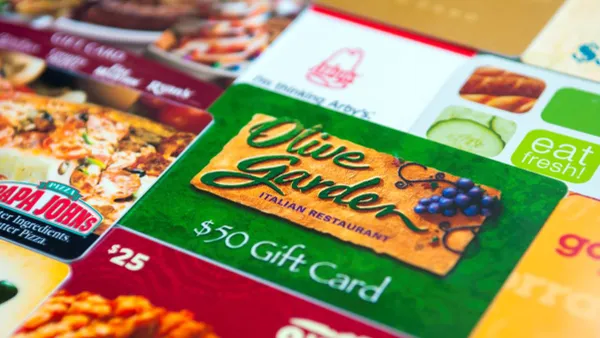Marketing materials play a vital role in a restaurant's success – from splashy posters highlighting a new app to back-of-house training modules. These days, many restaurants are innovating on the fly, trialing new menu items or printing literature to accompany delivery and catering orders to help boost brand loyalty. Yet with the bulk of project management attention focused on the creative and branding elements of these pieces, it's easy to forget the logistics, as in the printing and shipping.
But what happens if a brand launches a new seasonal menu item without the proper promotional support or staff education in place? Potentially lost sales and profits.
Take a fast casual chain that realized it had an abundance of a certain ingredient. They decided to create a new dish, which meant they needed to distribute an updated menu to the field as quickly as possible. That can be a challenging feat anytime, but these days it may be harder than ever, given the current disruptions in the supply chain. Fortunately they knew of a service that could help them – FedEx Office.
Challenges inherent in the traditional printing and shipping process
For decades, restaurants have relied on a standard model where they print materials in bulk and ship them to locations. However, that process typically requires extensive lead times, and with the current pace of business, that can lead to obsolescence – and wasted time and money. For example, in today's uncertain environment, many restaurants are shifting hours of operation or updating pricing more regularly.
Eateries are searching for ways they can be more agile and pivot on the fly to take advantage of new opportunities. A key aspect of this nimble approach is preparing crucial marketing materials more quickly.
"Distributed print" to the rescue
FedEx Office fulfills this need with its "distributed print" model that is designed to speed materials where and when they are needed. "The term is intended to convey the fact that we can produce materials digitally prior to printing them, which allows for more efficient and effective deliveries," explains Amit Sangani, senior manager for FedEx Office Hub of Excellence.
Through FedEx Office robust network, which includes about 2,200 stores and 17 manufacturing facilities strategically located across the United States, clients can access infrastructure equipped to produce large-run projects. A brand can place an order at one facility, with orders then flowing into the retail network so the marketing materials can be produced at the facility that's closest to the end user.
"With the power of the FedEx Office network, we have the ability to potentially save money on shipping because we can produce the materials closer to the point of consumption," Sangani says. This practice also may offer substantial environmental benefits, with closer shipping distances leading to reduced energy use.
Customers can choose from two kinds of models in the distributed print process. In a self-service model, the company sets up the design, brand guidelines, legal disclaimers and other details, and then each location orders the quantity they need. "With this solution the brand can be sure all the restaurants have the approved menus, pricing, messaging, signage and other elements which all adhere to brand guidelines," says Sangani. However, then the individual restaurant operator can make slight customizations online, such as indicating their store hours, and order the amount they individually need to be printed and delivered by the FedEx Office location closest to them.
The second model caters to a corporate entity that wants to oversee the entire process. Rather than relying on each location to order their own, they do it on their behalf and send the completed pieces directly to them. The FedEx Office team can take a project that entails the same materials, same weight and same delivery locations, and because they have access to the 17 facilities in their network instead of just one printing plant, they may be able to offer savings on both shipping costs and transit time.
Many of their customers use both models at various times, Sangani says, relying on FedEx Office trusted advisors to determine which model will help them better execute a given strategy from a corporate perspective.
A holistic, seamless process
When creating a marketing project with FedEx Office, brands have access to a comprehensive team that includes consultation in strategy, design, sales and logistics. "Our aim with our one-stop, white-glove service is to alleviate the project management tasks that otherwise may fall to the brand when using a regular print provider," Sangani notes.
And while no company is immune to the current supply chain challenges, FedEx Office may have an inherent advantage as its volume allows it to source from paper mills directly, rather than relying on distributors. It also has alliances with a wide variety of providers, which opens the door to alternative options for clients.
Efficiency can boost profit
Restaurants are eager to pull in additional customers using an array of marketing materials that can advertise new locations, hours, promotions or menu items. And, as many grapple with staff shortages, they need to cross-train staff and quickly bring new team members up to speed. Having supporting materials readily available can have a significant impact on a restaurant's operations and is imperative to maintain a customer service focus.
Often restaurant managers who need to have materials produced for promotions or to support operations are unaware of how they may be able to shave off costs and distribution time, finds Russ Dearborn, regional account manager for FedEx Office. "In a world where many restaurants are being squeezed by increased labor and food costs, it makes sense to figure out what options there are for a distribution system that may lower costs."
As you plan your 2022 strategies, FedEx Office distributed print may help your restaurant's marketing run more smoothly. Contact FedEx Office to learn more.










